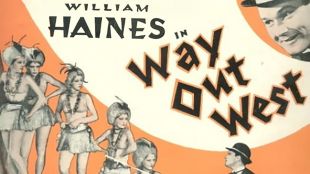
The early, pre-code days of sound coincided with a relatively liberal attitude towards homosexuality, which explains a lot of what goes on in the first half of this Western comedy. Although the public wasn't widely aware of it, just about everyone in Hollywood knew that star William Haines was gay, and his films often contained subtle references to his sexual preference. In this picture these jokes are as close to the surface as they could possibly get in those days. Haines plays a carnival barker named Windemere -- better known as "Windy." When he cheats a group of cowboys out of their money, they drag him back to the ranch and force him to work off his debt to them. Windy goes through a number of humiliating experiences while he is at their mercy, but for the most part, he handles the situation with the brash, uptempo nature that Haines had made famous throughout his career. But there's something else going on underneath the cowboys' macho posturing. When Windy gets spiffed up for his latest chore at the ranch, the cowboys take a special delight in his appearance, and later on, one of them leads him around by the hand. More obvious is when Windy delivers breakfast to the ranch owner, Molly (Leila Hyams). Since her back is turned she assumes it's the cook, Pansy (Polly Moran). "Oh, you're not Pansy," she says when she turns around. "I'm the wildest pansy you ever picked," Windy replies. On a different note, another in-joke makes a reference to Haines' already-famous talent as an interior designer (he turned it into his second career after he was finished in movies). Molly is decorating the ranch for a dance and Windy offers to help. Molly, however, turns him down -- this became even more ironic after the fact because later on, Hyams became one of his clients. Windy, of course, proves his true manliness in the film's second half by saving Molly from a snakebite and braving a brutal sandstorm to bring her back home.
While modern day viewers -- especially those with some knowledge of film history -- are amused by this picture's in-jokes, they didn't do much for its box-office value. Way Out West made about half the profit of Haines' prior films and marked the beginning of his downhill slide in popularity. His character in his prior film, The Girl Said No, was not very sympathetic, and perhaps he started losing his popularity then. Way Out West may also have been a bit too quirky for the tastes of its era, although those same quirks are what hold it up as entertainment today. Whatever the case, Haines would spend the next several years making the transition from movie star to designer, which in the end he proved to be his true calling.
